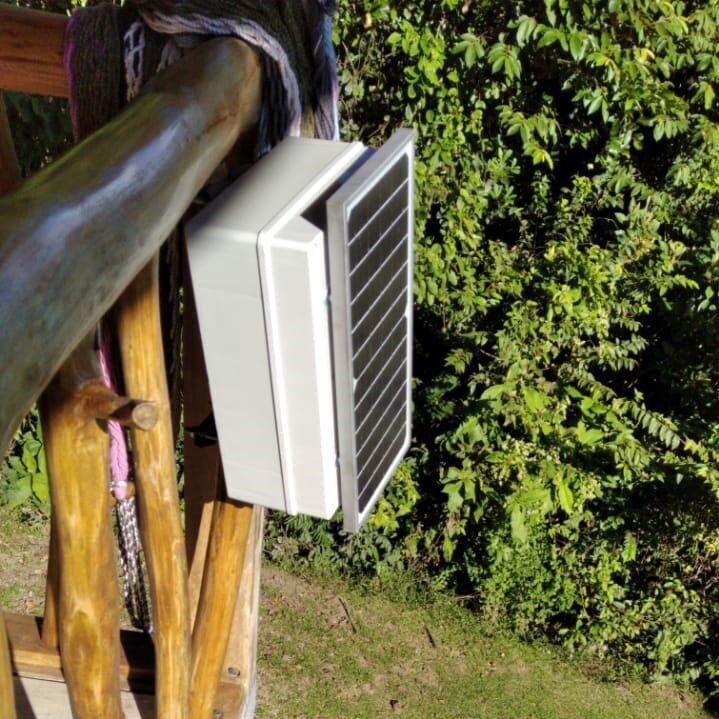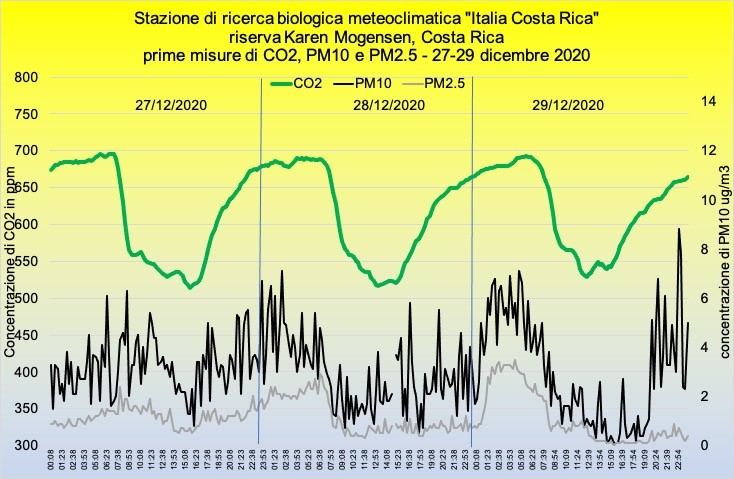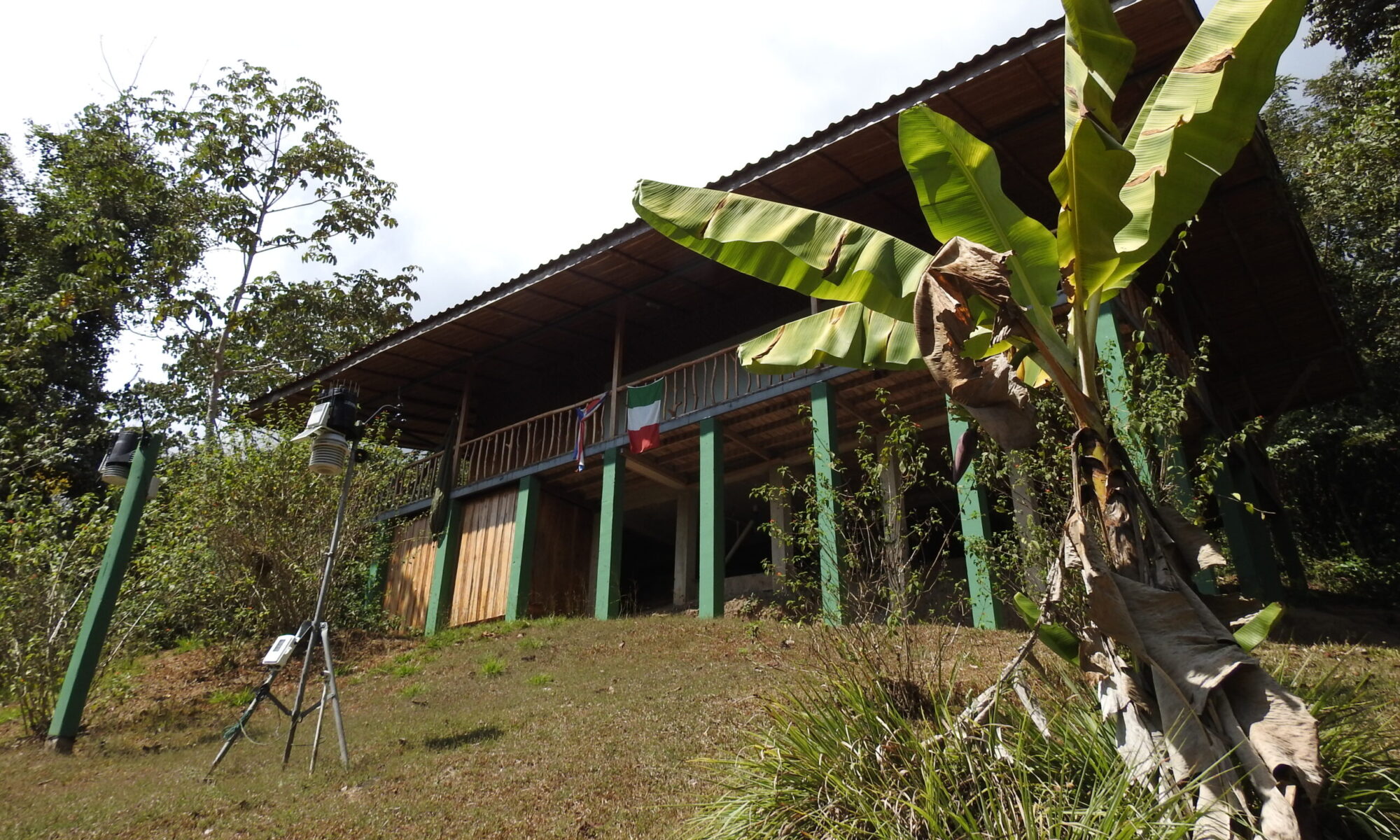The Biological and Meteoclimatic Research Station “Italia Costa Rica”, at the Karen Mogensen reserve of Asepaleco, is enriched with new tools for environmental measurements. Thanks to funds raised with donations in favour of Foreste per Semper OdV, a low cost system for air quality and atmospheric CO2 measurements was purchased and installed. The sensor apparatus was supplied by the Meteoproject company in Medicina (Bologna), in the version powered by a solar panel. The sensor provides measurements of fine particulate matter, PM2.5 and PM10 as well as CO2 concentration. Connected to the station’s Wi-Fi network, the sensor sends data every 15 minutes that enriches their history which can be consulted in real time at https://www.biometeo.org/en/weather-2/weather/
The new instrument was installed by prof. Dario Sonetti, who is currently in Costa Rica, with the supervision of the meteorologist Luca Lombroso for the positioning, setting and configuration aspects. The support provided by Stefano Guerra, owner of Meteoproject, is also precious, both for practical advice and for the preparation of the database and web pages. The complete data and the archive are in fact available on this page, kindly hosted by Meteoproject. http://www.meteoproject.it/ftp/stazioni/karen/index.php

The purpose of the tool is primarily informative, to have comparative data available from a place that, from the first measurements, is confirmed to have truly pure and uncontaminated air. Despite the limits of the type of instrument, we will therefore try to carry out initial assessments on natural particulate matter, on any phenomena of transport of pollutants, on the CO2 cycle and its absorption processes in the Karen Mogensen Reserve, as well as verify the trend over the years long term of these data. The current low cost measures are the basis for future expansions and improvement of the existing meteorological and environmental instrumentation. The concentrations of PM2.5 and PM10 measured in the first days are very low, close to the minimum detectable by the instrument, sometimes even lower than 1 µg/m3 in the concentrations of PM10, rarely reach 10 µg/m3 while the more harmful, PM2.5, almost always remains below 5 µg/m3. To give an idea, the city of Modena rarely sees, only on very clear and windy days, concentrations below 15-20 µg/m3 of PM10 while in days of smog emergency they also exceed 100 µg/m3 in both parameters. We also remind you that the Italian legal limit for PM10 is 50 µg/m3 of average daily value not to be exceeded for more than 35 days a year.
Moreover, it is reasonable to believe that in addition to the low concentrations of particulate matter, they are almost entirely made up of components of natural origin, such as pollen, dust from the soil, transported marine particulate and other organic and inorganic material. Of course it is a hypothesis that we hope to be able to confirm one day with measurements from more advanced instruments. Regarding the concentrations of carbon dioxide, better known as carbon dioxide or CO2, the discussion is more complex. CO2, remember, is not a pollutant but a greenhouse gas, and its dynamics mean that it spreads everywhere, so much so that the main detection stations are in remote places such as the island of Mauna Loa in Hawaii or at the top of mountains. such as Monte Cimone on the Modena Apennines, far from direct anthropogenic sources. In the forest, the behavior of concentrations is made complex by the cycle of the vegetation itself. To these are added the weather effects, in particular the diurnal and nocturnal evolution of the mixed layer.
Thus, the first data showing concentrations ranging between about 500 and 700 ppm should not surprise and are not comparable with the concentrations of the reference stations mentioned above, which are around 410 ppm. On the other hand, the sensor for practical reasons is installed at the station itself, under the forest canopy. The trend of the first few days of measurement that we show you in the following graph is still very interesting. In fact, a diurnal cycle is noted, with minimum concentrations in the hottest hours and maximums at night.

This “breath of the forest”, as we like to call it, is due to two factors, one weather, linked to the diurnal atmospheric mixing and stagnation of the air at night, and the other the vegetation cycle itself.
Aspects that will be studied in depth over time, continuing the measurements and supporting high-precision instruments in the future, together, we hope, with study and research activities dedicated to these complex aspects, fundamental for the study and fight against climate change and the conservation of biodiversity.
Text by Luca Lombroso and Dario Sonetti

